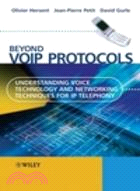| FindBook |
有 1 項符合
BEYOND VOIP PROTOCOLS: UNDERSTANDING VOICE TECHNOLOGY AND NETWORKING TECHNIQUES的圖書 |
 |
BEYOND VOIP PROTOCOLS: UNDERSTANDING VOICE TECHNOLOGY AND NETWORKING TECHNIQUES 作者:HERSENT 出版社:JOHN WILEY & SONS,LTD 出版日期:2005-01-01 |
| 圖書館借閱 |
| 國家圖書館 | 全國圖書書目資訊網 | 國立公共資訊圖書館 | 電子書服務平台 | MetaCat 跨館整合查詢 |
| 臺北市立圖書館 | 新北市立圖書館 | 基隆市公共圖書館 | 桃園市立圖書館 | 新竹縣公共圖書館 |
| 苗栗縣立圖書館 | 臺中市立圖書館 | 彰化縣公共圖書館 | 南投縣文化局 | 雲林縣公共圖書館 |
| 嘉義縣圖書館 | 臺南市立圖書館 | 高雄市立圖書館 | 屏東縣公共圖書館 | 宜蘭縣公共圖書館 |
| 花蓮縣文化局 | 臺東縣文化處 |
|
|
- 圖書簡介
In 1999-2000, VoIP (Voice-over-IP) telephony was one of the most successful buzzwords of the telecom bubble era. However, in 2001-2003, VoIP faced a very tough reality check. Now, manufacturers and service providers are drawing on what they have learnt from past experience in order to prepare to participate in the next major challenge faced by the telecommunications industry.
This book offers a comprehensive overview of the issues to solve in order to deploy global revenue-generating effective "multimedia" services. Drawing on extensive research and practical deployment experience in VoIP, the authors provide essential advice for those seeking to design and implement a post-bubble VoIP network.
Beyond VoIP Protocols: Understanding Voice Technology and Networking Techniques for IP Telephony
Introduces the basics of speech coding and voice quality
Demonstrates how quality of service may be built into the network and deals with dimensioning aspects, e.g. multipoint communications and how to model call seizures.
Explores the potential of multicast to turn an IP backbone into an optimized broadcast medium
Includes amply illustrated, state-of-the-art practical advice for formulating a complete deployment strategy
A companion volume to "IP Telephony: Deploying VoIP Protocols", this book takes the reader a stage deeper into how to prepare the network and exploit VoIP technology to its full potential. - 目次
Glossary.
List of Abbreviations.
1. Introduction.
1.1 The rebirth of VoIP.
1.2 Why beyond VoIP protocols?
1.3 Scope of this book.
1.4 Intended audience.
1.5 Conclusion.
1.6 References.
2. Introduction to Speech-coding Techniques.
2.1 A primer on digital signal processing.
2.2 The basic tools of digital signal processing.
2.3 Overview of speech signals.
2.4 Advanced voice coder algorithms.
2.5 Waveform coders. ADPCM ITU-T G.726.
2.6 Hybrids and analysis by synthesis (ABS) speech coders.
2.7 Codebook-excited linear predictive (CELP) coders.
2.8 Quality of speech coders.
2.9 Conclusion on speech-coding techniques and their near future.
2.10 References.
2.11 Annexes.
3. Voice Quality.
3.1 Introduction.
3.2 Reference VoIP media path.
3.3 Echo in a telephone network.
3.4 Delay.
3.5 Acceptability of a phone call with echo and delay.
3.6 Conclusion.
3.7 Standards.
4. Quality of Service.
4.1 Introduction: What is QoS?
4.2 Describing a data stream.
4.3 Queuing techniques for QoS.
4.4 Signaling QoS requirements.
4.5 The CableLabs® PacketCableTM quality-of-service specification: DQoS.
4.6 Improving QoS in the best effort class.
4.7 Issues with slow links.
4.8 Conclusion.
4.9 References.
4.10 Packet size annex.
5. Network Dimensioning.
5.1 Simple compressed voice flow model.
5.2 Building a network dedicated to IP telephony.
5.3 Merging data communications and voice communications on one common IP backbone.
5.4 Multipoint communications.
5.5 Modeling call seizures.
5.6 Conclusion.
5.7 References.
6. IP Multicast Routing.
6.1 Introduction .
6.2 When to use multicast routing.
6.3 The multicast framework.
6.4 Controling scope in multicast applications.
6.5 Building the multicast delivery tree.
6.6 Multicast-routing protocols.
6.7 The mBone.
6.8 MULTICAST issues on non-broadcast media.
6.9 Conclusion.
6.10 References .
Index.
|











